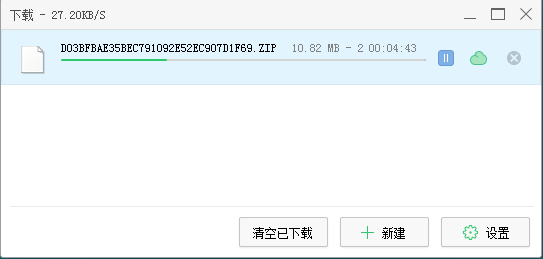SpringMVC 文件下载的两种方式
41571 Java | 2022-7-29-
现如今又要写一个关于下午的业务,因此再次编写测试用例,总结了两种下载方式。
首先介绍一个14年就写的文章,Http断点下载实简单讲解(http://www.javacui.com/java/98.html )

基于Spring的ResponseEntity
/** * SpringMVC方式 */ @GetMapping("/downSpring") public ResponseEntity<byte[]> down() throws Exception { if(System.getProperty("os.name").contains("Windows")){ System.out.println("操作系统Windows"); }else{ System.out.println("操作系统Linux"); } String filePath = "D:\\temp\\SGWSRootCA.jks"; byte [] body = null; try { InputStream in = new FileSystemResource(filePath).getInputStream(); body = new byte[in.available()]; in.read(body); } catch (IOException e) { throw e; } //添加响应头 HttpHeaders headers = new HttpHeaders(); //这里fileName有可能出现下载文件乱码-需要自己处理 headers.add("Content-Disposition", "attachment;filename=SGWSRootCA.jks"); headers.setContentType(MediaType.APPLICATION_OCTET_STREAM); HttpStatus statusCode = HttpStatus.OK; ResponseEntity<byte[]> responseEntity = new ResponseEntity<>(body, headers, statusCode); return responseEntity; }Java通用下载方式
/** * 普通HTTP流输出方式 */ @GetMapping("/downJava") public void downJava(HttpServletRequest request, HttpServletResponse response) throws Exception { String filePath = "D:\\temp\\SGWSRootCA.jks"; //设置响应头和客户端保存文件名 response.setCharacterEncoding("utf-8"); response.setContentType("multipart/form-data"); response.setHeader("Content-Disposition", "attachment;fileName=SGWSRootCA.jks"); try { //打开本地文件流 InputStream inputStream = new FileInputStream(filePath); OutputStream os = response.getOutputStream(); byte[] b = new byte[2048]; int length; while ((length = inputStream.read(b)) > 0) { os.write(b, 0, length); } // 这里主要关闭。 os.close(); inputStream.close(); } catch (Exception e){ throw e; }finally { // 是否删除原文件在这里操作 } }那么我们再基于第二种方式,写一个功能,就是网页引用一张图片,这个图片是二维码,具体二维码内容是什么,是后台程序控制。
这里生成本博客访问的二维码来编写测试代码。
package com.example.springboot.controller; import cn.hutool.core.io.FileUtil; import cn.hutool.extra.qrcode.QrCodeUtil; import org.springframework.web.bind.annotation.GetMapping; import org.springframework.web.bind.annotation.RequestMapping; import org.springframework.web.bind.annotation.RestController; import javax.servlet.http.HttpServletResponse; import java.io.File; import java.io.FileInputStream; import java.io.InputStream; import java.io.OutputStream; @RestController @RequestMapping("/test/file") public class FileController { /** * 获得博客地址二维码的图片 */ @GetMapping("/getMyBlogQr") public void getMyBlogQr(HttpServletResponse response){ // 组装下载文件路径,区分Linux和Win String filePath; String fileName = "javacui.jpg"; if(System.getProperty("os.name").contains("Windows")){ filePath = "D:\\temp\\" + fileName; }else{ filePath = "/home/" + fileName; } // 生成二维码,存在就不用再次生成 // 生成指定url对应的二维码到文件,宽和高都是300像素 if (!new File(filePath).exists()) QrCodeUtil.generate("http://www.javacui.com/", 300, 300, FileUtil.file(filePath)); //设置响应头和客户端保存文件名 response.setCharacterEncoding("utf-8"); response.setContentType("multipart/form-data"); response.setHeader("Content-Disposition", "attachment;fileName=" + fileName); try { //打开本地文件流 InputStream inputStream = new FileInputStream(filePath); OutputStream os = response.getOutputStream(); byte[] b = new byte[512]; int length; while ((length = inputStream.read(b)) > 0) { os.write(b, 0, length); } // 这里主要关闭。 os.close(); inputStream.close(); } catch (Exception e){ } } }然后在页面使用一个图片标签,指向这个接口即可
<img src="http://localhost:1088/test/file/getMyBlogQr" style="width: 300px; height: 300px;">
打开HTML页面可以看到:

基于ResponseEntity的实现的局限性还是很大,从代码中可以看出这种下载方式是一种一次性读取的下载方式,在文件较大的时候会直接抛出内存溢出。
还有就是这种方式在进行下载统计的时候也存在局限性,无法统计在下载失败的情况已完成下载量,因此限制了对下载的功能扩展。
虽然这种实现方式有局限性,但是也有着优点,简洁。在很多时候我们并不需要那么复杂的下载功能时,这种实现就应该是首选了。
然而下载java通用实现在功能上比第一种实现更加丰富,对下载的文件大小无限制(循环读取一定量的字节写入到输出流中,因此不会造成内存溢出,但是在下载人数过多的时候应该还是出现一些异常,较大文件时可以采用其他策略)。
另外因为是这种实现方式是基于循环写入的方式进行下载,在每次将字节块写入到输出流中的时都会进行输出流的合法性检测,在因为用户取消或者网络原因造成socket断开的时候,系统会抛出SocketWriteException,系统可以捕捉这个过程中抛出的异常,当捕捉到异常的时候我们可以记录当前已经传输的数据量,这样就可以完成下载状态和对应状态下载量和速度之类的数据记录。
另外这种方式实现方式还可以实现一种断点续载的功能。
推荐您阅读更多有关于“ 下载 springmvc 断点续传 springboot ”的文章
-
猜你喜欢
评论:
- 个人资料
-

Java小强
未曾清贫难成人,不经打击老天真。
自古英雄出炼狱,从来富贵入凡尘。
- 站内搜索
-
- 文章分类
- 最新文章
- 热门文章
发表评论: